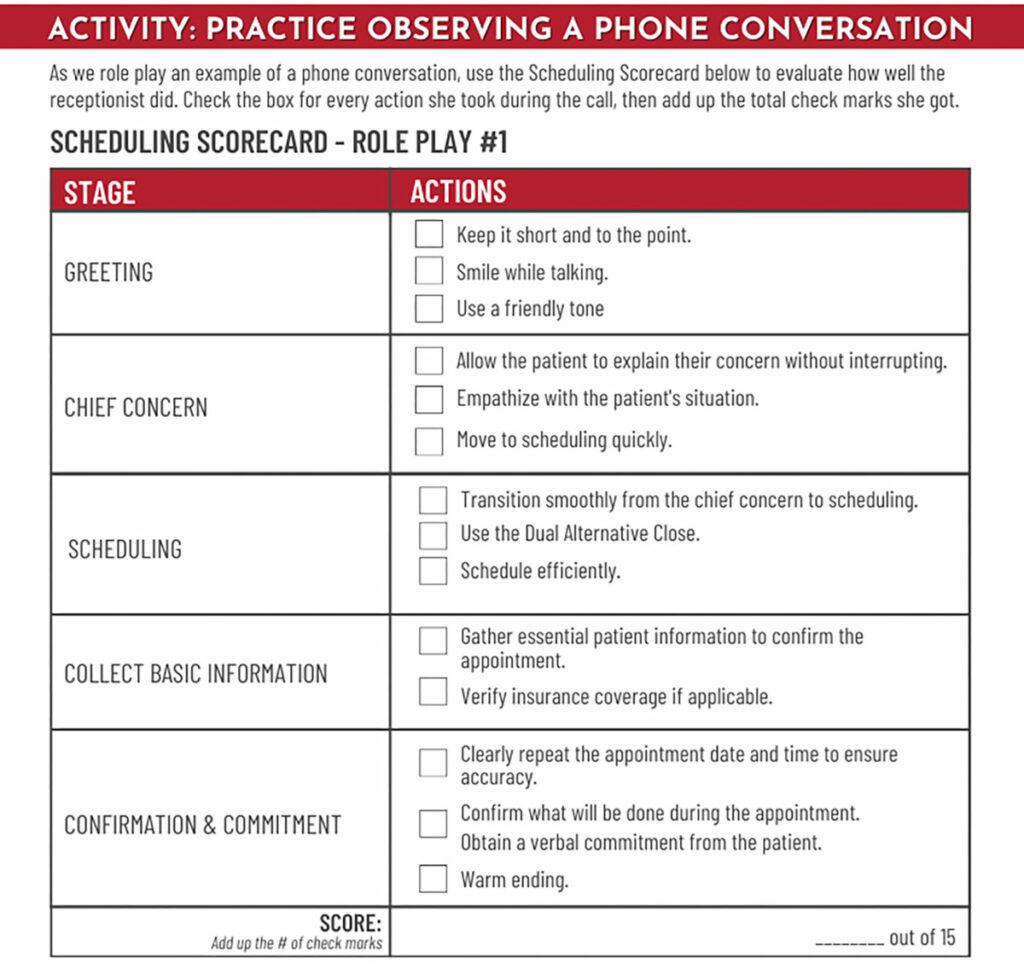The front office is the main command center for a dental practice. It’s also the secret to success for attracting new clients and retaining current ones.
The front office is often the first chance for a dental group practice to connect with patients. Indeed, answering the phone, scheduling, and ensuring re-appointments are activities central to patient retainment, and the patient experience overall.
Unfortunately, front office staff are often treated as the “junk drawer” of the dental group practice, said Amber Nish, Coach, DEO. One of the most common issues is that anything and everything can fall on the shoulders of those poor souls. Front office staff also rarely get defined job descriptions or KPIs, and their positions are usually entry-level and low-paid, yet they’re asked to be a catch-all for the organization without a clear understanding of how to improve at their jobs.
If dental leaders want to improve their marketing efforts and add revenue to their organization, the best place to start is the front office.

Knowing your front office
Front office personnel are any patient-facing team members whose key responsibilities include answering phones, scheduling appointments, checking out patients, and insurance verifications.
Nish said common themes DEO hears from dental organizations struggling with front office personnel include:
- Staff retention. Front office positions are often on the lower end of the pay scale.
- Inconsistency. Dental organizations don’t know if they’re going to get the same product out of each person.
- Hold times. Front office staff are often tied up on the phone with insurers waiting to get answers. How many phone calls are missed by these holdups?
- Knowledge. Do your front office staff know how to talk about your practice?
- Accountability. Do front office staff have clarity about their roles and expectations?
- Time off and scheduling conflicts. PTO, travel, maternal and paternal leave, and sick days all affect the ability of a dental organization to properly staff their front desk.
The KPIs your front office needs
Answering the phone is the number one job of your front office. Yes, interacting with patients coming in the door is important, but answering the phone is just as important for revenue purposes. Every missed or poorly managed call is lost revenue for a dental group practice.
It is the responsibility of dental leaders to help front desk employees by teaching and training them on phone etiquette, important information about the dental business, and customer service techniques like scripted calls, Nish said.
Front office staff need key performance indicators (KPIs) to succeed. The phone answer rate is their most important one. Dental businesses should aim for a 90% answer rate (or a 10% or less missed call rate).
The second critical KPI is increasing call conversion. When the practice picks up the phone, how do they ensure that the patient gets on the schedule?
Dental leaders must incentivize performance on each of the KPIs and make business decisions based on those numbers. Phone carriers can provide a number to practices that explain out of all the calls that came in, how many were answered and unanswered.
Voicemails don’t count toward the number of answered calls. If a patient leaves a voicemail, it means that nobody picked up the phone.
Review the numbers on the phone answer rate each week to better understand the times that calls tend to be missed, Nish recommends. Often, the time of day with the most unanswered calls is during lunch. This may mean that one staff member needs to stay back during lunch and answer calls, and then take their lunch when everyone returns. Another common time is missing calls first thing in the morning due to patients coming in for appointments.
Improving the unanswered call rate might mean taking other responsibilities off the front office’s docket. For example, responsibilities such as insurance verification can be outsourced online, using a remote team member, or another employee can take the bulk of that responsibility. Another responsibility that doesn’t have to necessarily be done by your front office staff is confirming appointments. How much time is spent on outbound calls? Can you use texting for a majority of that? You need to know your avatar and whether that will impact your business or not, but maybe you can use text platforms and go from three calls to one.
One way that call conversion can be increased is by setting it as a goal and measuring an associate’s performance against that goal.
Goals can depend on the avatar (or the customer base that a business serves). Then, front office employees should receive the proper training to succeed at the front office, which includes a written set of standard operating procedures and expectations kept at the front desk to keep employees on the same page.
Have employees practice expectations, give them feedback, and work together. Observe calls, use written guidelines, and see if the employee’s work matches the set expectations, and let them know what is missing if it is not. Monitor your associates’ progress until they can successfully complete calls on their own.

| Scheduling Stages • Greeting • Chief concern • Scheduling • Collect basic information • Confirmation and commitment |
When to centralize/outsource
At a certain point, it may make sense for your dental organization to centralize or even outsource your scheduling. The reasons to do this include:
- Not being able to consistently reach the goal of 90% answer rate or above
- Need to improve answer rate and conversion rate
- Struggling to hire and retain at the location
Dental organizations can go about this in several different ways. They can centralize only during overflow or certain high-volume hours like first thing in the morning or lunch. Another choice is to fully centralize. Dental organizations should weigh their options and make the best choice that fits their specific needs on whether to create a central location that would house their employees, create a remote team, or outsource to a third party.
Technology can also be used to decrease the number of inbound calls to a team through software such as direct online scheduling, texting, chat sections of the website, or Q&A pages. All these options allow patients to get info and make appointments elsewhere, decreasing the need for calls.
Anatomy of a great call
What makes a great call? Patients want to feel heard when they call the office, and they want to be scheduled quickly, Nish said. Front office staff should be empathetic listeners and know how to guide the conversation.
Start with a warm, welcome greeting to the patient when they call. Then, identify quickly why the patient is calling. Identify the concern or the key reason for the call, repeat it back to the patient, and then work to schedule the patient the proper appointment.
This preliminary call is where patients want to tell their story, so associates should listen well. The patient may be in pain, so gauging the need for an emergency appointment and getting them in as soon as possible is an important evaluation to be made during this time.
Offer two options to patients when scheduling, and if necessary, repeat those options, until the patient settles on a time that works best for them and for the practice. Then move to collecting the patient’s information to secure the appointment, verify insurance, confirm the appointment, and get a commitment from the patient to pay. This will help with no-show and cancellation rates because the patient has already provided their info, and it also speeds up the case presentation and acceptance process in the office.
| Phone Scripts Train • Train your team members using a written guide of expectations. • Have your team members practice it a few times with you and give them feedback. Coach • Observe some calls and use the written guide of expectations to evaluate their performance. • Give them concrete feedback on what they did well and what they missed. • Repeat until they’re consistently getting this almost perfect. |
For example:
“Miss Jones, I have you scheduled at 8 a.m. on June 8 with Dr. Smith. I’m going to send you an email with a link to fill out your health history online. Can you do that before your appointment? And if anything should change and you need to reschedule your appointment, will you give us at least 48 hours’ notice?”
The final part of the call is the follow-up, which puts a nice bow on the patient interaction. Analyze if this is happening in your practice, and if it is not, determine ways to get that integrated into your practice’s calling routine.
In terms of coaching staff to make more impactful calls to patients, the clinical owner should listen to an example call, hear how it went, and give the employee feedback that they can take with them to use in calls going forward. Use scorecards to help employees recognize their strengths and improve their skills.
Leaders should start making improvements to the front office by looking into call conversion rates, setting standard operating procedures for calls made to patients, having scorecards ready for employees so that they are carrying out their procedures the best they can, and working with teams to ensure that they are performing at their best. Each of these aspects makes a world of difference when using your front office as a catalyst for adding revenue.





